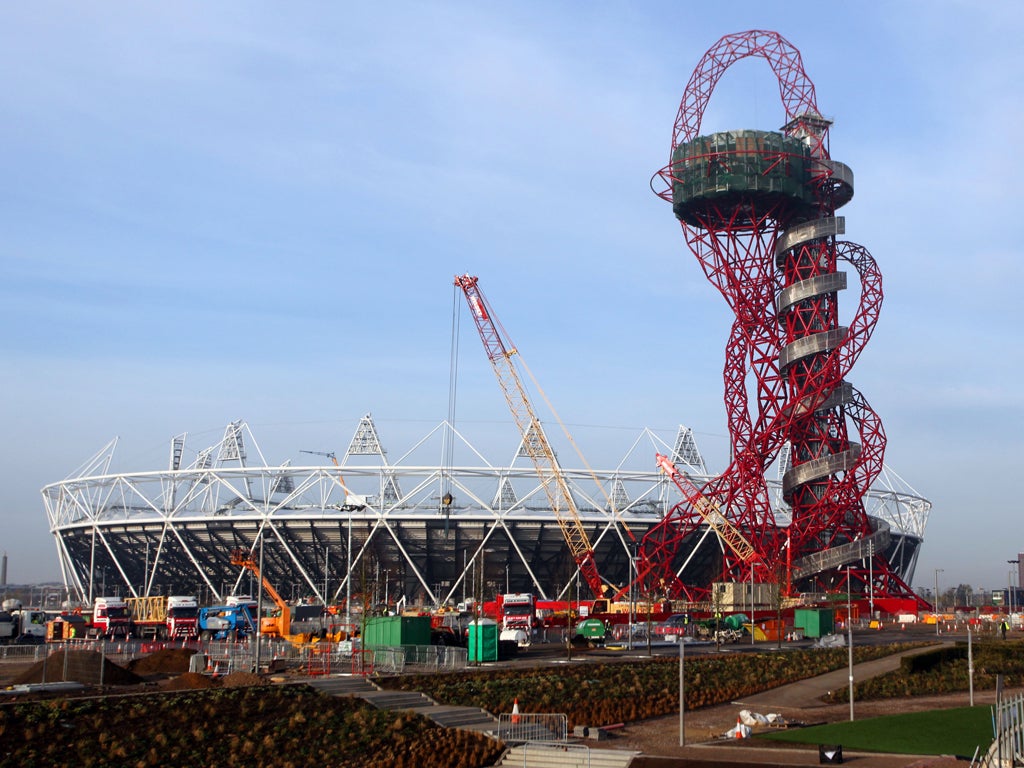Designed by Anish - built by Kirk, Matt, Andy, John and Wayne

Standing nearly twice as tall as the Olympic Stadium, the crazed and twisted steelwork of the ArcelorMittal Orbit tower is an undeniably impressive piece of engineering. Consider that it was bolted together by just three men, and its loops and spirals seem more imponderable than ever.
Come the 2012 London Games next summer, this scarlet monster standing between the metal colloseum that is the stadium and the swooping roof of the Aquatic Centre will treat 5,000 visitors to exalted views across the Olympic Park every hour.
It was designed by Anish Kapoor and Cecil Balmond. But the people they have to thank for almost the entirety of its complicated assembly are a core team of only three erectors – foreman Matt Collier and his two assistants, Kirk Bilby and Andy Canning – led by construction manager John Calland and dimensional engineer Wayne Heaton.
They're a tight-knit unit, as you might expect of five men who had to live together in a house in South Woodford for the whole of the 10-month project. And it was a particularly challenging project too. Asked what his first impressions were on seeing plans for the Orbit, Mr Calland answers with characteristic dry humour: "How the f*** are we going to put this together?"
"This structure's been made to look as if it wants to fall over," he says. "We had to build it leaning north, because when you hang all the metal on the other side it pulls it over, so as we added bits the whole tower moved over – it was a moving target at all stages." When attempting to make giant sections of metal weighing up to 60 tons connect in 16 places, with up to 10 bolts at each join and barely millimetres to play with, a moving target was the last thing they needed.
"When we positioned the base nodes we were all in awe," says Mr Heaton, "because we were looking at a picture of it and thinking: how are we going to get those so correct that they will match at the top?"
The team are keen to highlight the fine job done by the factory technicians who made the perfectly fabricated parts, and by the drivers of what Mr Calland describes as the "ballet of cranes" needed to hoist them up to fasten the bolts. But for men whose steelwork on most building sites is later hidden away by exterior masonry, having
their craft left open and on view to the world is a welcome change.
"It's fantastic, you can see everything," says Mr Collier, before deadpanning: "You can see all the bolts that are untied..." There is a moment of nervous laughter from the PRs before he smiles and reassures us they are fastened, really.
Engineers can sometimes resent it when the architects get all the plaudits, and one jokes: "I haven't seen Anish putting any f***ing bolts in." Yet under their brusque exteriors they all seem genuinely enthused about what they have created. Plus they must all have some Olympic tickets as a reward, right?
"You got some tickets, didn't you John?" says one of the erectors. "Yeah, for the table tennis," he sniffs.
Subscribe to Independent Premium to bookmark this article
Want to bookmark your favourite articles and stories to read or reference later? Start your Independent Premium subscription today.

Join our commenting forum
Join thought-provoking conversations, follow other Independent readers and see their replies